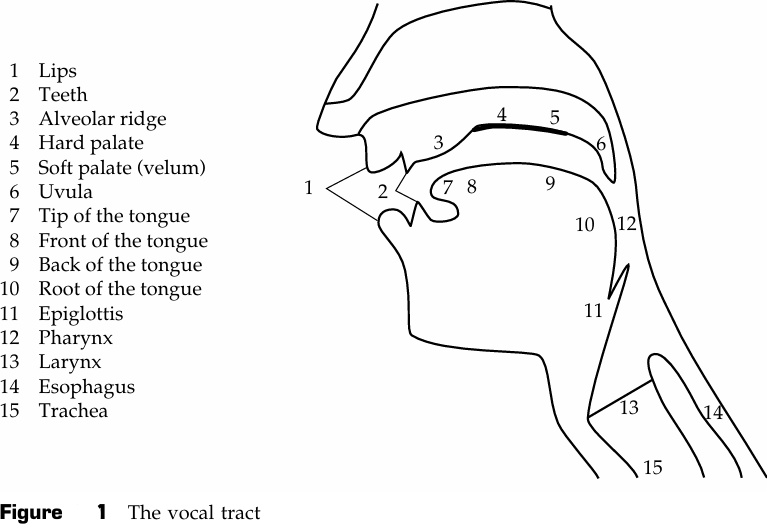


 Grammar
Grammar
 Tenses
Tenses
 Present
Present
 Past
Past
 Future
Future
 Parts Of Speech
Parts Of Speech
 Nouns
Nouns
 Verbs
Verbs
 Adverbs
Adverbs
 Adjectives
Adjectives
 Pronouns
Pronouns
 Pre Position
Pre Position
 Preposition by function
Preposition by function 
 Preposition by construction
Preposition by construction
 Conjunctions
Conjunctions
 Interjections
Interjections
 Grammar Rules
Grammar Rules
 Linguistics
Linguistics
 Semantics
Semantics
 Pragmatics
Pragmatics
 Reading Comprehension
Reading Comprehension|
Read More
Date: 2024-04-13
Date: 2024-06-27
Date: 2024-05-14
|
Description and Articulation of Sounds of English
The vocal tract
Our examination of how sounds are made will begin with the vocal organs. The air we use in sound production comes from the lungs, proceeds through the larynx where the vocal cords are situated, and then is shaped into specific sounds at the vocal tract. In sound production, it is generally the case that the articulators from the lower surface of the vocal tract (lower articulators, i.e. the lower lip, the lower teeth, and the tongue) move toward those that form the upper surface (upper articulators, i.e. the upper lip, the upper teeth, the upper surface of the mouth, and the pharyngeal wall).
Starting from the outer extreme, we have the lips and the teeth. In the upper surface, behind the upper teeth, there is a bumpy area (the alveolar ridge), which is followed by a larger bony area (the hard palate). Further back is a flaccid area, the ‘soft palate’ (or ‘velum’), which is unsupported by bone. The soft palate is a movable organ, which opens and closes the velopharyngeal passage (the passage that links the pharynx to the nasal cavity). Finally, at the back, the velum narrows to a long, thin pointed structure that is called the ‘uvula’.
In the lower part of the mouth, after the lower lip and the teeth, lies the tongue. The ‘tip’ (or ‘apex’) of the tongue is the foremost part. Just behind the tip is the small surface called the ‘blade’ (or ‘lamina’). The so-called ‘front’ part of the tongue is the area between the tip/blade and the center. The hindmost part of the horizontal surface of the tongue is called the ‘back’ (or ‘dorsum’). At the end of the tongue, we have the ‘root’, which is the vertical surface against the pharyngeal wall. Finally, we have the ‘epiglottis’, which is a leaf-shaped cartilage that sticks up and back from the larynx.

|
|
|
|
التوتر والسرطان.. علماء يحذرون من "صلة خطيرة"
|
|
|
|
|
|
|
مرآة السيارة: مدى دقة عكسها للصورة الصحيحة
|
|
|
|
|
|
|
نحو شراكة وطنية متكاملة.. الأمين العام للعتبة الحسينية يبحث مع وكيل وزارة الخارجية آفاق التعاون المؤسسي
|
|
|